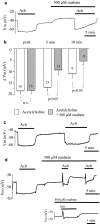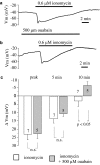Na+-K+-ATPase is involved in the sustained ACh-induced hyperpolarization of endothelial cells from rat aorta
- PMID: 17001300
- PMCID: PMC2014692
- DOI: 10.1038/sj.bjp.0706913
Na+-K+-ATPase is involved in the sustained ACh-induced hyperpolarization of endothelial cells from rat aorta
Abstract
Background and purpose: Inhibition of Na(+)-K(+)-ATPase is known to attenuate endothelium-dependent relaxation in many arteries. The purpose of this study was to evaluate the role of Na(+)-K(+)-ATPase in the regulation of endothelial membrane potential at rest and during stimulation by ACh.
Experimental approach: Membrane potential was recorded from the endothelium of rat aorta using the perforated patch-clamp technique.
Key results: Superfusion with K(+)-free solution produced a depolarization of about 11 mV from the resting value of -42.9+/-0.9 mV. Reintroduction of 4.7 mM K(+) transiently hyperpolarized endothelial cells to -52.4+/-1.8 mV and the membrane potential recovered within 10 min. Ouabain 500 microM depolarized endothelium by about 11 mV and inhibited the hyperpolarization induced by K(+) reintroduction into the K(+)-free solution. However, 500 nM ouabain did not affect the resting membrane potential or the hyperpolarization induced by K(+) reintroduction. Pre-exposure to ouabain 500 microM, but not 500 nM, attenuated the sustained component of hyperpolarization to ACh without affecting the amplitude of the transient peak hyperpolarization. In K(+)-free solution, the amplitude of peak hyperpolarization to ACh was increased, while the sustained component of hyperpolarization was attenuated.
Conclusions and implications: These results indicate that electrogenic Na(+)-K(+)-ATPase partially contributes to the sustained hyperpolarization of endothelial cells from rat aorta in response to ACh. They also suggest that the alpha1, but not alpha2 or alpha3 isoforms, is involved in ACh-mediated hyperpolarization.
Figures







References
-
- Blanco G, Mercer RW. Isozymes of the Na,K-ATPase: heterogeneity in structure, diversity in function. Am J Physiol. 1998;275:F633–F650. - PubMed
-
- Blaustein MP, Lederer WJ. Sodium/calcium exchange: its physiological implications. Physiol Rev. 1999;79:763–854. - PubMed
-
- Brayden JE. Membrane hyperpolarization is a mechanism of endothelium-dependent cerebral vasodilation. Am J Physiol. 1990;259:H668–H673. - PubMed
MeSH terms
Substances
LinkOut - more resources
Full Text Sources
Molecular Biology Databases

